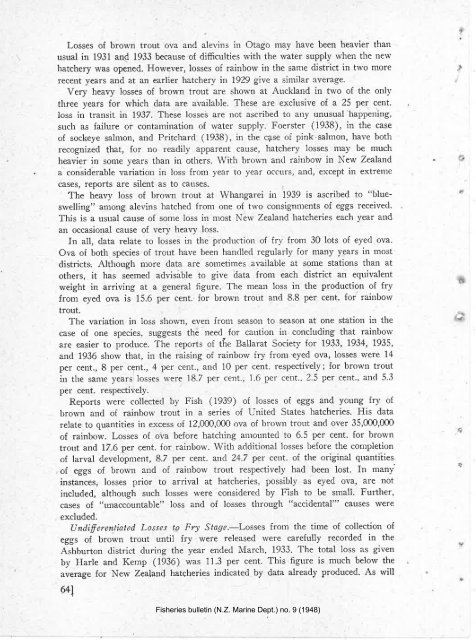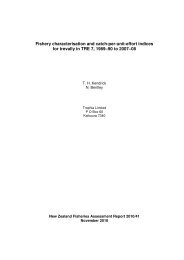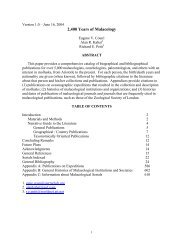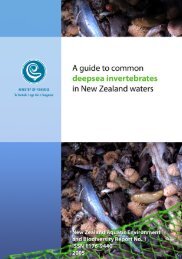N.Z. MARINE DEPARTMENT-FISHERIE,S BULLETIN No. .į
N.Z. MARINE DEPARTMENT-FISHERIE,S BULLETIN No. .į
N.Z. MARINE DEPARTMENT-FISHERIE,S BULLETIN No. .į
You also want an ePaper? Increase the reach of your titles
YUMPU automatically turns print PDFs into web optimized ePapers that Google loves.
Losses of brown trout ova and alevins in Otago may have been heavier than<br />
usual in 1931 and 1933 because of diffrculties witli the water supply when the new<br />
lratchery was opened. However, losses of rainbow in the sarne district in two more<br />
recent vears and at an earlier hatchery in 1929 give a similar average.<br />
Very heavy losses of brown trout are shown at Auckland in two of the only<br />
three years for which clata are available. These are exclusive of. a 25 per cent.<br />
loss in transit in 1937. These losseS are not ascribed to atly unusual happening,<br />
such as failure or contamination of water supply. Foerster (1938), in the case<br />
of sockeye salttton, and Pritcharcl (1938), in the c4se o[ pink-salmon, l,ave both<br />
recognizecl that, for no readily apparent cause, hatchery losses nray be much<br />
heavier in some years than in others. With brown ancl rainbow in New Zealand<br />
a considerable variation in loss from year to year occtlrs, ancl, except iu extreme<br />
cases, reports are silent as to catlses.<br />
The heavy loss of l¡rown trout at Whangarei in 1939 is ascribed to "blueswelling"<br />
among alevins hatched from one of two consignnrents of eggs receivecl.<br />
This is a usual cause of some loss in n'rost New Zealand hatcheries each year and<br />
an occasional cause of very heavy loss.<br />
In all, data relate to losses in the procluction of fr¡' from 30 lots of eyecl ova'<br />
Ova of both species of trout have been hancllecl regularly for many years in tlost<br />
districts, Although more clata are sornetimes available at some stations than at<br />
others, it has seemed advisâble to give data from each district an equivalent<br />
weight in arriving at a general figure. The meau loss in the production of fry<br />
from eyed ova is 15.6 per cent. for brown trourt and B.B per cent. for rair,bow<br />
trout.<br />
The variation in loss shown, even from seasoll to season at one station in the<br />
case of one species, suggests the need for caution in concluding that rainbolv<br />
are easier to procluce. The reports of tËe Ballarat Society for 1933, 1934,7935,<br />
and 1936 show that, in the raising of rainbow fry from'eyed ova, losses were 14<br />
per ce¡t., 8 per cent., 4 per cent., ancl 10 per cent. respectively; for brown trotrt<br />
in the satne years losses w'ere 18.7 Per cent., 1.6 per cent.,2.5 per ceut., ancl 5.3<br />
per cent. respectively.<br />
Reports were collected by Fish (1939) of losses of eggs and young fry of<br />
brown ancl of rainbow trout in a series of lJnited States hatcheries. His data<br />
relate to quantities iu excess of 12,0@,000 ova of brown trout ancl over 35,000,000<br />
of rainbow. Losses of ova before hatching amounted to 6.5 per cent. for brown<br />
trotrt and 17.6 per cent. for rainbow. With aclditional losses before the completion<br />
of larval development, 8.7 per cent. ancl 241 per cent. of the original quantities<br />
of eggs of brown and of rainbow trout respectively had been lost. In many<br />
instances, losses prior to arrival at hatcheries, possibly as eyecl ova, are not<br />
inclucled, although such losses were considerecl by Fish to be small. Further,<br />
cases of "nnaccountable" loss and of losses through "accidental"' caLlSeS w€re<br />
excluded:<br />
Und,ifferenti,ateil Losses to Fry Stage.-Losses from the tir¡e of collection of<br />
eggs of brown trout until fry were released were carefully recorded in the<br />
Ashburton clistrict cluring the year enclecl March, 1933. The total loss as given<br />
by Harle and Kemp (1936) was 11.3 per cent. This figure is rnuch below the<br />
average for New Zealand hatcheries indicatecl by data already produced, As will<br />
641<br />
Fisheries bulletin (N.Z. Marine Dept.) no. 9 (1948)







